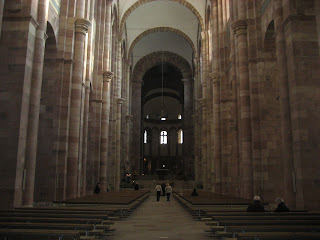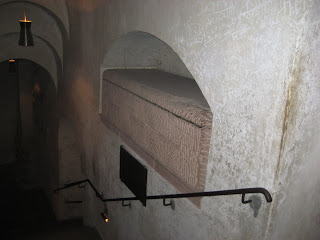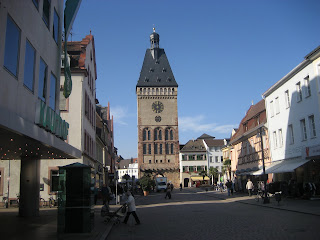Day 14 - Speyer was founded around 50 AD by the Romans and flourished during the Middle Ages. However, much of it was destroyed in the 17th century during the Palantine War of Succession. Little of its past glory survived except for the Romanesque Cathedral that was built between 1030 and 1125.



The crypt is of special interest, since it has retained its original condition to the present day. Being the official church of the Salic Emperors, eight German Emperors and Kings, four queens and a number of bishops were buried here.
Emperor Konrad II, buried 1039
Empress Gisela, wife of Konrad II, buried 1043
Emperor Heinrich III, buried 1056
Emperor Heinrich IV, buried 1111
Emperor Heinrich V, buried 1125
Empress Beatrix, second wife of Friedrich Barbarossa, buried 1184
Agnes, daughter of Friedrich Barbarossa, buried 1184
King Philipp of Swabia, Son of Friedrich Barbarossa, buried 1216
King Rudolf of Habsburg, buried 1291
King Adolf of Nassau, buried 1309



At the opposite end of the main street is the City Gate. This is one of the tallest city gates in Germany. It was constructed between 1230 and 1250. You can walk up countless stairs to the top to see Speyer from above. Inside there's an exhibition on city fortifications.

That afternoon was our Discovery Series Home-Hosted Kaffeeklatsch with a local family. We arrived at the home of Sybil who proceeded to explain how her present home was a farm house. Her present "apartment" was the pig sty, the area her one son occupies had been the goat and horse stable. Her twin sons occupy what was the main house. A large barn sits in the rear and behind that her garden. It is amazing how much she had growing in a relatively small space.
We went inside to have coffee or tea and some of her lovely cakes. She had made a chocolate torte, a cream torte, plum cake, apple cake, coconut balls and sugared walnuts. That was way more than the 7 of us could eat. I had eaten a light lunch and skipped dessert so I could enjoy her offerings. I was not disappointed. We had a nice conversation about life in Germany before being taken back to the ship.



